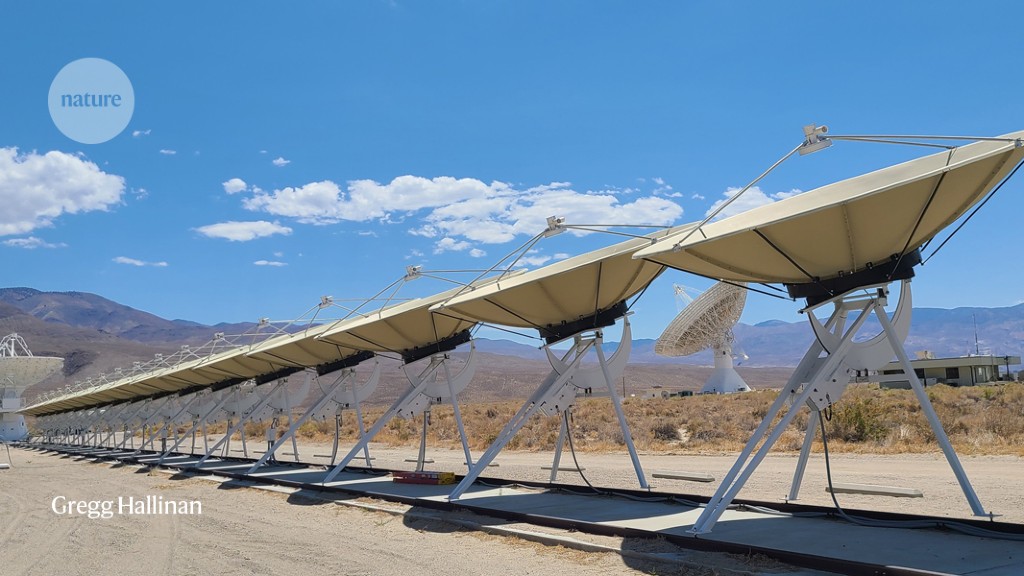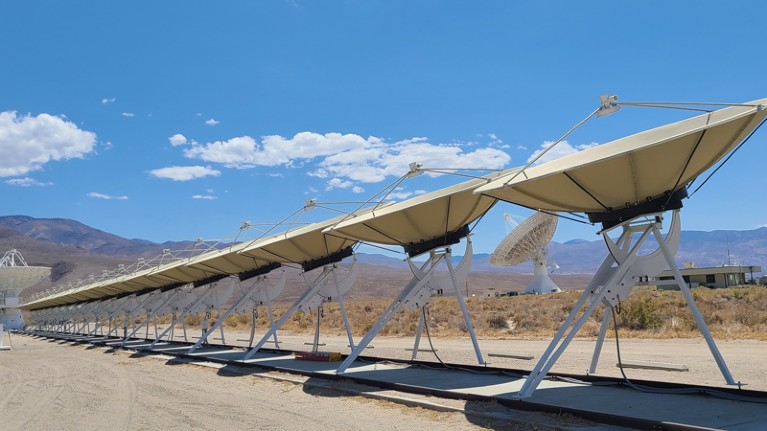The Deep Synoptic Array in California’s Owens Valley can precisely locate the point in the sky where a fast radio burst occurs. When completed, it will comprise 110 dishes, each 4.65 metres wide.Credit: Gregg Hallinan
Powerful, milliseconds-long blips of radiation known as fast radio bursts (FRBs) have puzzled scientists since they were discovered in 2007. Although their exact causes remain uncertain, astronomers are now beginning to use the bursts as tools to probe the cosmos — from untangling the nature of the cosmic web to measuring the expansion of the Universe.
“I am pretty bullish about FRBs becoming a basic astronomical tool in the near future,” says Di Li, an astronomer at the National Astronomical Observatories in Beijing.
FRBs are thought to come from sources such as pulsing dead stars or cataclysmic events, mostly outside the Milky Way. These events are compact but incredibly powerful, releasing 500 million times more energy than the Sun does over a given duration. The gas that each FRB passes through on its way to Earth — both while leaving its home galaxy and as it crosses the space between galaxies — leaves telltale imprints on the signal.
So far, astronomers have largely used the available FRB data to locate and learn about the home galaxies of the bursts, but they are starting to make wider inferences about the distribution and structure of matter that is otherwise difficult to study.
Observatories are detecting FRBs at an unprecedented rate and increasingly can pinpoint which galaxies they come from, says Kiyoshi Masui, a radio astronomer at the Massachusetts Institute of Technology in Cambridge. “We will have statistically powerful samples far sooner than we had expected,” he says.
Treasure troves of information
FRBs make good cosmic probes because their radio waves interact with any medium they traverse. The overall amount of matter, as well as density fluctuations within it, leaves a trace on the signal, as do magnetic fields. The ability of an FRB to reveal information about its journey has “great scientific power”, even if teasing apart the imprint from different stages remains a challenge, says Xavier Prochaska, an astrophysicist at the University of California, Santa Cruz.
A magnetic field, for example, rotates the radio waves’ polarization, the direction in which their electric fields oscillate. Astronomers want to know about magnetic fields because they affect how matter flows and how galaxies form. In a preprint1 posted on the arXiv last September, Prochaska and colleagues showed that nine FRBs came from galaxies with magnetic fields similar in strength to the Milky Way’s. Once astronomers can pinpoint the source galaxies of around 100 FRBs, they will be able to explore wider trends, such as whether mass or galaxy type correlates with magnetic-field strength, says Prochaska. “At that stage, we can really inform galaxy-formation models,” he says.
First and foremost, FRBs can reveal the total amount of matter that they encounter as they travel. Low-frequency components of the waves slow down more than high-frequency ones, leaving a smeared-out signal. The greater the smearing — known as dispersion — the more matter the wave has travelled through.
In 2020, astronomers used dispersion measures of five localized FRBs to shed light on a long-held mystery — the location of more than half of the Universe’s ordinary matter that is spread out as a gas2, rather than concentrated in galaxies. Cosmology predicts this matter must exist, but because the gas density is low, it had proven maddeningly difficult to fully account for. The team, led by Jean-Pierre Macquart at Curtin University in Perth, Australia, showed that the correlation between the FRBs’ distance and their dispersion measures roughly matched the expected amount of missing matter.
However, not all FRBs fit the correlation neatly. That’s because the missing matter is not evenly distributed across space, but swirls around and between galaxies in filaments known as the cosmic web. Astronomers working on the FLIMFLAM survey3 now want to use a sample of 30 localized FRBs to map the cosmic web more precisely. For each FRB, they plan to subtract estimates for the dispersion caused by various stages of the journey — the host galaxy, other galaxies the signal skirts and the Milky Way — so that they can better constrain how much matter must sit in the cosmic web in between.
Even more answers
How smeared out an FRB is can also tell astronomers about the properties of gas on a smaller scale. Vikram Ravi, an astronomer at the California Institute of Technology in Pasadena, and his colleagues have been using FRBs as skewers to observe the gas that sits around galaxies in haloes, known as the circumgalactic medium. In a paper published on the arXiv this month4, the team used the dispersion measure of an FRB that skimmed the Milky Way’s own halo to put an upper limit on the amount of gas present there, and showed that it is far less than expected. The researchers say the finding supports the idea that matter is regularly spewed out from galaxies in a process known as feedback. Supernovae and stellar winds eject matter while gravity pulls it in — a process that is hard to model on a computer simulation. “FRBs can help a lot” with understanding this process, which is fundamental to understanding how galaxies form, says Yin-Zhe Ma, an astronomer at the University of Kwazulu-Natal in Durban, South Africa.
Astronomers are even attempting to use FRB dispersion to measure how fast galaxies are flying away from each other because of the Universe’s expansion, which is described by the Hubble constant. Cosmology theories — together with the Hubble constant — predict a specific relationship between an FRB’s distance and how stretched out it should appear. By plugging in observed values for the dispersion measure and distance, astronomers can flip the equation to instead give a best-fit value for the Hubble constant.
The constant has been measured with high precision, but different methods have yielded contradictory results. So far, the values that FRB researchers have calculated have such a large uncertainty, around 10%, that they can’t help to settle the question5. But the figure will become more precise with more localized FRBs, says Esanmouli Ghosh, a student at the Indian Institute of Science Education and Research Mohali in Manauli, who presented one such study5 at the International Astronomical Union’s General Assembly 2022 in Busan, South Korea, in August.
The method could be promising, says astronomer Adam Riess at Johns Hopkins University in Baltimore, Maryland, but a major challenge is working out how much of a FRB’s dispersion is due to the relevant matter in intergalactic space and how much comes from the host galaxy and the Milky Way. This problem is common to all efforts to use FRBs as probes, but astronomers are working on several methods to estimate how much dispersion comes from each part of the journey, says Prochaska. “I feel optimistic,” he says.








More News
Judge dismisses superconductivity physicist’s lawsuit against university
Future of Humanity Institute shuts: what’s next for ‘deep future’ research?
Star Formation Shut Down by Multiphase Gas Outflow in a Galaxy at a Redshift of 2.45 – Nature